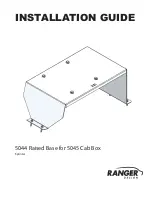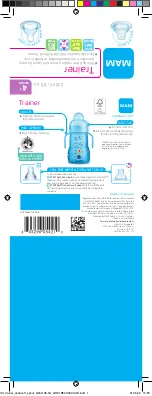
4. CHARGING
4.1.
CHARGING METHOD FOR ROADSTART MOBILE POWER SYSTEMS
4.1.1.
Only use the AC chargers provided for each unit. This is the preferred method as it is automatic and does not require the user to monitor
the progress of the charge. Furthermore whenever the unit is not in use it can safely be left connected to the charger.
4.2.
READING THE POWER LEVEL INDICATORS (figs.3 & 4)
The charge level of each unit can be seen at any time by pressing the test button and noting the number of red power level lights that
are illuminated. When all the power level lights are illuminated the unit is fully charged and is ready to be used. If only two red lights
are illuminated the unit is in a 50% charge status and could be used to operate most 12 volt accessories. If the unit is required for
starting it should be charged until all three red lights are illuminated. If there is only one red light illuminated the unit is low and must be
recharged. If the amber charging light begins to flash on 12V models this means that the battery voltage has dropped to 7.25V or below
and the unit will not work until it is fully recharged.
4.3.
INITIAL CHARGING PROCEDURE
4.3.1.
Before first use, these roadstart units should be charged for a minimum of 72 hours.
WARNING!
Use supplied adaptor, cables and connectors. Unauthorised parts may damage the unit and will invalidate the warranty.
Ensure you strictly apply the safety regulations as stated in Section 1.
4.4.
To recharge with the AC charging adaptor
Only charge with the adaptor supplied with your specific model. See below. The adaptors are not interchangeable.
4.4.1.
RS1.V5 & RS102.V4
Use the charger supplied (fig.5). Plug the AC charger cable into the charge input socket of the unit. This socket
is situated on the back of the unit at the top of the label (fig.1).
4.4.2.
RS103.V3
Use the charger supplied (fig.5). The adaptor charging jack is inserted into the charge port, located beneath the LED
power indicators.
4.4.3.
Ensure the power clamps are in the appropriate holsters.
4.4.4.
Plug the charger itself into any 230 Volt AC wall outlet. The amber ‘Charging’ indicator will illuminate, (fig.3).The unit will now charge
automatically and the power level lights will indicate the level of charge. When the green ‘Charged’ LED comes on (fig.3) charge for a
further 3 to 6 hours to achieve full capacity. When not in use these Roadstart can be left connected to the charger.
4.5.
Recharging with the 2-pin European adapter
When using the Roadstarts in a European country remove the 3-pin UK plug by pushing the button on the adapter and turning
anti-clockwise, replace with the 2-pin plug, placing it on the transformer and turning clockwise until fully home (fig.5).
5. OPERATION
WARNING! You must follow the safety instructions
5.1.
PREPARATION AND PRECAUTIONS
WARNING! Ensure that the roadstart and vehicle voltages are the same
.
5.1.1.
Apply the vehicle hand brake and place in neutral gear (or “Park” if automatic transmission).
5.1.2.
Turn ignition and electrical accessories off.
5.1.3.
Use in a well ventilated area and wear protective eye shields and clothing.
NOTE:
A defective battery may not accept a charge from the portable power source.
WARNING! DO NOT
allow the red and black clamps to touch each other. Ensure that clamps are connected correctly before use.
WARNING!
Modern vehicles contain extensive electronic systems. You are required to check with the vehicle Manufacturer for any
specific instructions regarding the use of this type of equipment on each vehicle. No liability will be accepted for damage/injury where
this product is not used in accordance with all instructions.
Emergency Jump Starter
NOTE:
For optimum performance, the unit should not be stored below 10°C when using the unit as a jump starter.
IMPORTANT:
These RoadStart units are suitable to jump start a vehicle even if the vehicle’s battery is discharged (voltage is greater
than 0.7V).
5.1.4.
Turn off the vehicle ignition.
5.1.5.
Attach the RED (po) clamp to the positive terminal of the battery.
NOTE:
On vehicles with multiple batteries connect positive clamp to positive battery terminal which is connected to vehicle electrical
system.
5.1.6.
Attach the BLACK (negative -) clamp to the vehicle chassis.
5.1.7.
Ensure that all cables are clear of moving belts and rotating fans.
5.1.8.
Maintain a safe distance from the battery whilst jump starting.
5.1.9.
Turn on the ignition to start the vehicle.
NOTE:
If the vehicle does not start after 6 seconds, allow the RoadStart unit to cool for 3 minutes, before attempting to jump start the
vehicle again. If this is not done, the unit could sustain damage.
5.1.10. When the vehicle has started,
DO NOT
leave the RoadStart connected to the vehicle, quickly disconnect the BLACK (negative -)
clamp first from the vehicle chassis.
5.1.11. Remove the RED (po) clamp from the battery terminal.
5.1.12. Return the clamps to the side storage pockets.
WARNING! YOU MUST FOLLOW THE SAFETY INSTRUCTIONS
fig.3
RS1.V5 RS102.V4 RS103.V3 Issue 7 (3,4) 29/4/19
Original Language Version
© Jack Sealey Limited
fig.4
TEST
BUTTON
CHARGE
PORT
GREEN FULLY
CHARGED LED
RED POWER
LEVEL LEDS
AMBER
CHARGING
LEDS
RS103.V3
fig.5






















